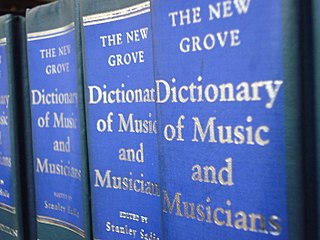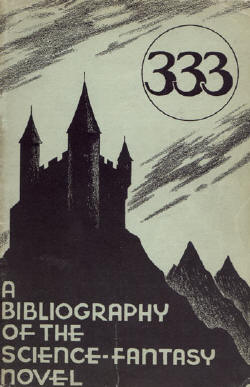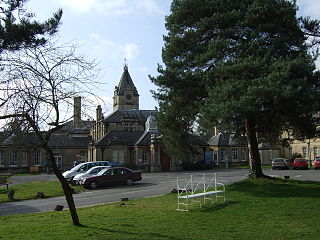
The New Grove Dictionary of Music and Musicians is an encyclopedic dictionary of music and musicians. Along with the German-language Die Musik in Geschichte und Gegenwart, it is one of the largest reference works on the history and theory of music. Earlier editions were published under the titles A Dictionary of Music and Musicians, and Grove's Dictionary of Music and Musicians; the work has gone through several editions since the 19th century and is widely used. In recent years it has been made available as an electronic resource called Grove Music Online, which is now an important part of Oxford Music Online.
The Oxford Classical Dictionary (OCD) is generally considered "the best one-volume dictionary on antiquity," an encyclopædic work in English consisting of articles relating to classical antiquity and its civilizations. It was first published in 1949, edited by Max Cary with the assistance of H. J. Rose, H. P. Harvey, and Alexander Souter. A second edition followed in 1970 (OCD2), edited by Nicholas G. L. Hammond and H. H. Scullard, and a third edition in 1996 (OCD3), edited by Simon Hornblower and Antony Spawforth. A revised third edition was released in 2003, which is nearly identical to the previous third edition. A fourth edition was published in 2012 (OCD4), edited by Simon Hornblower, Antony Spawforth, and Esther Eidinow. In 2016, a fully digital edition launched online, edited by Sander Goldberg (2013–2017) and Tim Whitmarsh (2018–present). Continuously updated on a monthly basis, this edition incorporates all 6,300 entries from OCD4 as well as newly commissioned entries, and features multimedia content and freely accessible maps of the ancient world.

The Complete Guide to Middle-earth: from The Hobbit to The Silmarillion is a reference book for the fictional universe called Middle-earth of J. R. R. Tolkien's legendarium, compiled and edited by Robert Foster. It was first published in 1971 under the title A Guide to Middle-earth. A revised and enlarged edition under the title The Complete Guide to Middle-earth was published in 1978. It received a third edition in 2001.

The Oxford Advanced Learner's Dictionary (OALD) was the first advanced learner's dictionary of English. It was first published in 1948. It is the largest English-language dictionary from Oxford University Press aimed at a non-native audience. Users with a more linguistic interest, requiring etymologies or copious references, usually prefer the Concise Oxford English Dictionary, or indeed the comprehensive Oxford English Dictionary, or other dictionaries aimed at speakers of English with native-level competence.

Thornton's Bookshop was the oldest university bookshop in Oxford, England. It was founded in 1835 by Joseph Thornton (1808–1891) in Magdalen Street.
Walton Manor is a residential suburb in Oxford, England. It is north of Jericho and the Radcliffe Observatory Quarter and forms part of North Oxford. The street layout and many of the area's buildings date from the mid-19th century. It was developed on land belonging to St John's College, Oxford.
William Barrow was a Bishop of Bangor and a Bishop of Carlisle.

333: A Bibliography of the Science-Fantasy Novel is a bibliography of English science fiction and fantasy books compiled and edited by Joseph H. Crawford, Jr., James J. Donahue and Donald M. Grant. It was first published by The Grandon Company in an edition of 450 paperback and 50 hardback copies. The hardback was issued without jacket. The book gives plot descriptions of 333 novels published prior to 1951.

The Warneford Hospital is a hospital providing mental health services at Headington in east Oxford, England. It is managed by the Oxford Health NHS Foundation Trust.
Sir Adam Roberts is Emeritus Professor of International Relations at the University of Oxford, a senior research fellow in Oxford University's Department of Politics and International Relations, and an emeritus fellow of Balliol College, Oxford.
Thomas Rodborne DD was an English medieval churchman and university chancellor.
Robert Colman DD was an English medieval Franciscan friar and university Chancellor.
Robert Aylesham was an English medieval university vice-chancellor and chancellor.
Walter Giffard was an English medieval theologist, university vice-chancellor, and university chancellor.
Elyas de Daneis was an English medieval university vice-chancellor. In 1230, Elyas de Daneis became the first Vice-Chancellor of the University of Oxford.
Martin Lyndsey DD was an English 16th-century university vice-chancellor,
Thomas Musgrave was an English 16th-century university vice-chancellor,
Richard Benger was an English 16th-century university vice-chancellor,
William Broke was an English 16th-century college head and university vice-chancellor at the University of Oxford.
Richard Barnack was an English 16th-century vicar and vice-chancellor at the University of Oxford.





